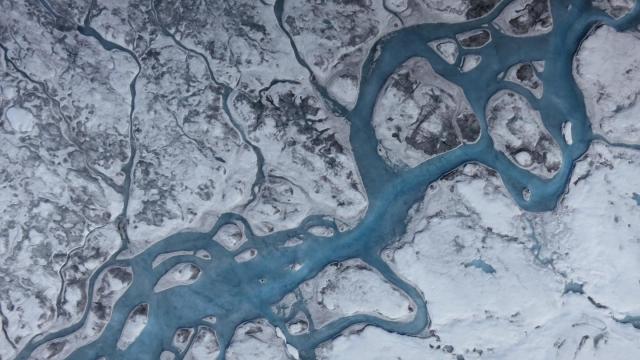Greenland is one of the brightest spots on planet Earth, but ominously enough, its gleaming surface darkens with each passing year, thanks to a strange series of physical processes, one of which cannot be seen with the naked eye.
According to a fascinating new study led by Columbia’s Earth Institute and published today the journal The Cryosphere, which finds that Greenland’s “albedo”, or reflectivity, has been decreasing since the mid ’90s. By the end of the 21st century, Greenland could be ten per cent darker than it is today. And that’s bad news for the ice sheet’s long term prospects, because, as anyone who has ever made the mistake of running in a black t-shirt on a hot summer day knows, darker surfaces absorb more heat.
One would think that a massive chunk of land changing colour would have attracted more attention. But the processes behind The Darkening are subtle, and in some cases, impossible for humans to see without the aid of technology.
The first culprit is tiny impurities — dust and soot grains — buried just beneath the surface of the ice sheet. As fresh snow melts in the summertime, deeper and dirtier layers of ice are exposed, rendering the surface a bit darker. As the researchers explain in their paper, especially warm summers can cause several years worth of impurities to become concentrated at the ice sheet’s surface.
The second reason has to do with a change in the reflective properties of the ice itself. As snowpack melts and refreezes, individual ice grains tend to get larger. Larger grains have less surface area and scatter less sunlight, therefore absorbing more solar energy. This effect, the authors say, is strongest in the infrared range, which is invisible to human eyes but can be seen with satellites.
But if you thought humans were off the hook on this one, not so fast. The last few months marked one of the most freakishly hot Arctic winters in recent memory — and that’s a direct symptom of human-caused climate change. With more hot days in Greenland’s future, we can expect the ice sheet to darken more quickly.
“Rising temperatures are promoting more melting, and that melting is reducing albedo, which in turn is increasing melting,” lead study author Marco Tedesco said in a statement. “As warming continues, the feedback from declining albedo will add up.”
Aerial image of Greenland, showing rivers of meltwater and patches of dark ice, via Marco Tedesco/Lamont-Doherty Earth Observatory
